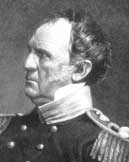Biographies
 Winfield Scott
Winfield Scott General Winfield Scott
General Winfield Scott was among the most celebrated American soldiers of his day. Born in Virginia in 1786, he received appointment as a captain of light artillery in 1808 with assignment to New Orleans. In the War of 1812, officers assigned Scott to the Niagara Frontier, where he distinguished himself in combat on numerous occasions. By the end of the war he had risen to brevet Major General and had received a Congressional gold medal and a reputation for discipline, earning him the nickname “Old Fuss and Feathers.”
In the following decades, Scott served against Indians in the Southeast and authored the army’s drill manual. President John Tyler elevated him to commander of all U.S. forces in 1841. An outspoken Whig, he opposed President James K. Polk’s policies toward Mexico, a move that cost him the primary field command in the ensuing U.S.-Mexican War. When General Zachary Taylor’s campaign bogged down at Monterrey, Scott proposed a bold plan to land an army at Vera Cruz and to march overland to capture Mexico City. Polk grudgingly agreed, and Scott’s campaign succeeded brilliantly and won the war.
Scott’s battlefield successes did not translate into political success. Two of his subordinates, Zachary Taylor and Franklin Pierce, rode their Mexican War reputations into the White House. Even so, Secretary of War Jefferson Davis, also a war hero, promoted Scott to brevet Lieutenant General in 1857.
Scott’s last great service to his country came in 1861 when he became the architect of Union war planning. Scott authored the “Anaconda Plan”, by which the North would strangle the South with a blockade and capture of the Mississippi River. He resigned from his post in late 1862 and retired to West Point, where he died in 1866.










